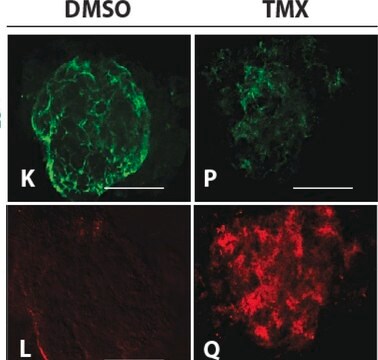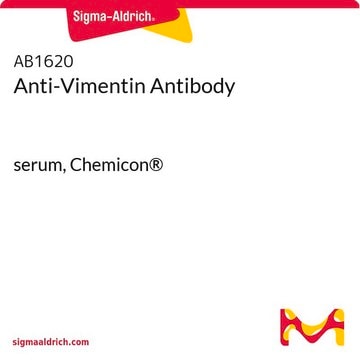MABT121
Anti-Vimentin Antibody, clone 3CB2
clone 3CB2, from mouse
Synonym(s):
Vimentin
About This Item
Recommended Products
biological source
mouse
Quality Level
antibody form
purified antibody
antibody product type
primary antibodies
clone
3CB2, monoclonal
species reactivity
chameleon (GLIA 15:389-400 (1995), Prada, F. A., et. al.), rat (GLIA 15:389-400 (1995), Prada, F. A., et. al.), human, lizard
species reactivity (predicted by homology)
chicken (immunogen homology)
technique(s)
immunocytochemistry: suitable
immunohistochemistry: suitable
western blot: suitable
isotype
IgMκ
NCBI accession no.
UniProt accession no.
shipped in
wet ice
target post-translational modification
unmodified
Gene Information
human ... VIM(7431)
General description
Immunogen
Application
Western Blot Analysis:
A representative lot was used to detect vimentin in chicken and rat total brain extracts (Prada, FA., et al. (1995). GLIA 15:389-400).
Immunohistochemistry Analysis:
A representative lot was used to detect vimentin in E3 chick embryo sections and different regions of the developing chick central nervous system (Prada, FA., et al. (1995). GLIA 15:389-400).
Cell Structure
Cytoskeleton
Quality
Western Blot Analysis: A 1:1,000 dilution of this antibody detected Vimentin in ARPE19 cell lysate.
Target description
Physical form
Storage and Stability
Analysis Note
ARPE cell lysate
Disclaimer
Not finding the right product?
Try our Product Selector Tool.
Storage Class Code
10 - Combustible liquids
WGK
WGK 2
Flash Point(F)
Not applicable
Flash Point(C)
Not applicable
Certificates of Analysis (COA)
Search for Certificates of Analysis (COA) by entering the products Lot/Batch Number. Lot and Batch Numbers can be found on a product’s label following the words ‘Lot’ or ‘Batch’.
Already Own This Product?
Find documentation for the products that you have recently purchased in the Document Library.
Our team of scientists has experience in all areas of research including Life Science, Material Science, Chemical Synthesis, Chromatography, Analytical and many others.
Contact Technical Service







